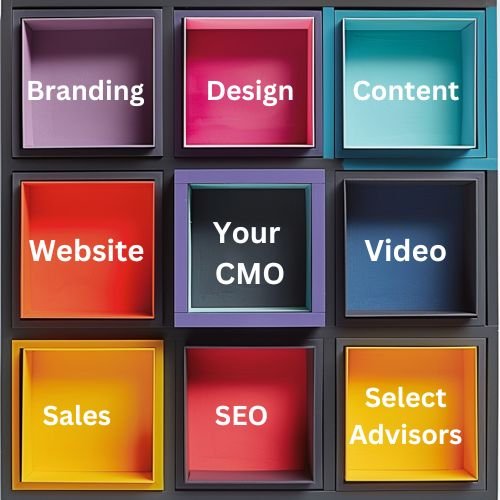You may be asking whether to hire an in-house Chief Marketing Officer (CMO) or engage an outsourced CMO (fractional or agency-led). This guide answers that question with practical pros and cons, cost and talent trade-offs, integration and performance expectations, and concrete decision criteria tailored for financial and legal advisory firms. Select Advisors Institute has been helping financial firms worldwide since 2014 to optimize talent, brand, and marketing, and this article frames the common choices, pitfalls, and outcomes advisors tend to face when choosing a marketing leadership model.
Q&A: What is an outsourced CMO and why are firms considering one?
Q: What is an outsourced CMO?
A: An outsourced CMO is an external marketing leader engaged part-time, on retainer, or project-by-project to set strategy, coordinate marketing execution, and provide senior expertise without full-time employment. Models include fractional CMOs (senior individuals), agency-led CMOs (teams with a lead), and consultancy arrangements. For financial and legal firms, outsourced CMOs often handle brand direction, growth strategy, compliance-aligned messaging, demand-generation plans, and vendor oversight.
Q: Why would a financial advisory or legal firm consider an outsourced CMO?
A: Common drivers include limited budgets for full-time executive hires, the need for specialized experience (digital wealth marketing, compliance, or B2B relationship marketing), accelerating transformation (rebrand, portal launches), and the desire for flexible expertise during growth phases or succession planning. Firms also use outsourced CMOs to bridge gaps while recruiting full-time leadership.
Q&A: Pros and cons of an outsourced CMO
Q: What are the pros of hiring an outsourced CMO?
A:
Cost efficiency: Pay for the level of senior expertise needed without full-time salary, benefits, and equity.
Speed and experience: Fractional CMOs often bring diverse sector experience and best practices across multiple firms.
Flexibility: Scale engagement up/down by project or hours; ideal for transitions, launches, or pilot programs.
Objective perspective: External leaders can challenge internal assumptions and introduce new strategies without internal politics.
Access to vendor networks: Outsourced CMOs usually bring vetted creative, digital, and PR partners, shortening procurement time.
Risk mitigation: Outsourced arrangements can test a leader’s fit before committing to full-time hire.
Q: What are the cons of an outsourced CMO?
A:
Limited day-to-day presence: May lack bandwidth for continuous internal relationship-building or crisis response.
Potential for fragmented ownership: If responsibilities and decision rights aren’t clarified, execution can stall between the outsourced CMO and internal staff.
Cultural fit: External leaders may need time to understand firm culture, compliance workflows, and advisor/client relationships.
Knowledge continuity: Short-term engagements risk losing institutional knowledge unless handoffs and documentation are strong.
Perception: Some stakeholders view outsourced leadership as less committed than an in-house executive.
Q&A: In-house vs outsourced CMO — how to compare
Q: In-house vs outsourced CMO — what are the main trade-offs?
A: The decision comes down to control vs flexibility, depth vs breadth, and cost vs continuity.
Control and alignment: In-house CMOs integrate more deeply into firm culture and operations, offering continuous presence for senior management, advisor coaching, and daily stakeholder alignment.
Flexibility and cost: Outsourced CMOs save on fixed payroll costs, are easier to replace or scale, and provide exposure to cross-firm best practices.
Time to value: Outsourced CMOs can often deliver faster strategic plans and vendor onboarding, while in-house leaders may take longer to hire and ramp.
Long-term brand stewardship: For firms prioritizing long-term brand and team development, an in-house CMO usually offers stronger continuity.
Q: Which firms should favor in-house CMOs and which should favor outsourced?
A:
Favor in-house: Mid-size to large firms with steady marketing volumes, cultures valuing deep internal leadership, or firms needing constant brand stewardship and advisor enablement.
Favor outsourced: Smaller firms, advisory groups in transition, firms launching new service lines, or those needing short-term ramp-up and strategic realignment without the full-time cost.
Q&A: Costs, contracts, and KPIs
Q: How do costs compare between in-house and outsourced CMOs?
A: Total cost of a full-time CMO includes base salary, bonuses, benefits, payroll taxes, recruiting fees, and onboarding—often 1.5x to 2x the salary in total employer cost. Outsourced CMOs are priced as hourly, retainer, or project fees and commonly provide comparable strategic leadership for a fraction of the annualized cost, especially when hired part-time. Budgeting should include vendor fees and execution budgets regardless of model.
Q: What contract terms and engagement models are typical?
A:
Fractional CMO: 10–80 hours/month on retainer; 3–12 month minimums are common.
Project-based: Fixed-price for defined deliverables (brand refresh, website, launch).
Agency-led: Monthly retainer with a lead CMO and execution team; scalable retainer bands.
Transition-to-hire: Consultancy phase followed by potential full-time offer.
Q: Which KPIs should firms track to evaluate CMO performance?
A:
Business-aligned KPIs: AUM growth attributable to marketing-sourced leads, new client acquisition cost, client retention rate improvements.
Marketing KPIs: Lead volume and quality, conversion rates across funnels, campaign ROI, website and content engagement.
Operational KPIs: Time-to-market for campaigns, vendor performance metrics, advisor engagement with marketing programs.
Brand KPIs: Net Promoter Score, brand awareness lifts, share of voice in target niches.
Q&A: Integration, governance, and risk mitigation
Q: How should firms integrate an outsourced CMO with existing teams?
A:
Clear RACI: Define Roles, Accountability, Consulted, and Informed for decisions spanning strategy to tactical execution.
Weekly touchpoints and monthly strategic reviews: Maintain rhythm to ensure alignment with business goals.
Documentation and playbooks: Require handoff-ready processes, brand guidelines, and vendor contracts to preserve continuity.
Compliance workflows: Prioritize joint workflows with legal/compliance to speed approvals and avoid regulatory missteps.
Q: What risks exist and how can they be mitigated?
A:
Risk: Conflicting direction between outsourced leader and internal stakeholders. Mitigation: Set initial 90-day priorities and a decision matrix.
Risk: Data security and confidentiality. Mitigation: Execute robust NDAs, data access controls, and vendor security checks.
Risk: Dependency on a single external leader. Mitigation: Ensure team depth and cross-training or require subcontractor access.
Q&A: How to choose an outsourced CMO provider
Q: What should a firm look for when selecting an outsourced CMO?
A:
Relevant experience: Track record with financial services or regulated industries and specific channel successes (e.g., advisor enablement, referral marketing).
Strategic and operational capability: Ability to both set strategy and oversee execution through vendors or internal teams.
Cultural and compliance literacy: Understanding of advisor economics, fiduciary language, and compliance review cycles.
Measured outcomes: Case studies and KPIs demonstrating measurable business impact.
References and chemistry: Interviews with past client firms and a cultural fit assessment.
Q: What questions to ask during vendor evaluation?
A:
How did you deliver measurable growth in comparable firms?
How will you work with our compliance function?
What does a typical 90-day plan look like?
Who will do the day-to-day execution?
How do you price and what are cancellation terms?
Q&A: When to transition from outsourced to in-house (or vice versa)
Q: When should a firm convert an outsourced CMO into a full-time hire?
A: Consider transition when the firm needs continuous, hands-on leadership, when marketing is core to revenue generation and advisor enablement requires daily coaching, and when budget supports the fixed cost. Successful signs include consistent traction from outsourced efforts, predictable marketing ROI, and a desire for deeper cultural integration.
Q: When should a firm move from an in-house model to outsourced?
A: Firms may pivot to outsourced leadership to reduce fixed costs, access specialized skills not present in-house, or when in-house leadership underperforms and a fresh external perspective is required.
Q&A: Practical examples and outcomes
Q: What are common wins firms see with a good outsourced CMO?
A:
Faster campaign launches with clear ROI tracking.
More efficient advisor onboarding to marketing programs.
Sharper messaging and higher-quality leads through targeted campaigns.
Better vendor negotiation and consolidated vendor management.
Reduced time for compliance approvals via established review templates.
Q: What failures should firms watch for?
A:
Lack of documented processes causing drops in execution quality after engagement ends.
Misaligned incentives where outsourced teams chase activity rather than business outcomes.
Poor data integration between marketing platforms and CRM causing attribution problems.
Q&A: Where Select Advisors Institute helps
Q: How does Select Advisors Institute support firms deciding between in-house and outsourced CMOs?
A: Select Advisors Institute provides tailored assessments, vendor/lead matching, fractional CMO placements, and marketing governance frameworks. Since 2014, the Institute has worked with advisory and legal firms globally to optimize marketing talent, brand positioning, and execution playbooks—helping firms choose the right leadership model and then operationalize it with measurable KPIs.
Q: What services are available from Select Advisors Institute?
A:
Fractional CMO placements and interim leadership.
Strategic audits and 90-day transformation plans.
Vendor evaluation and RFP facilitation.
Advisor enablement programs and brand refreshes.
Ongoing coaching and performance governance to ensure continuity and compliance.
Q: How to start an engagement with Select Advisors Institute?
A: Begin with a marketing and talent audit to define business goals, gaps, and a recommended leadership model (in-house, outsourced, or hybrid). The Institute helps define scope, select the right candidates or firms, and implement governance to measure outcomes.
Final checklist for advisors evaluating CMO options
Define business goals first: revenue growth, advisor enablement, brand rebuild, or digital transformation.
Assess internal capacity: Can current staff operationalize strategy or is senior leadership required?
Choose a model to match timeframe: short-term change favors outsourced; long-term brand stewardship favors in-house.
Require measurable KPIs and a 90-day plan in any engagement.
Insist on compliance-ready processes and documented handoffs.
Budget for execution: strategy without execution funding rarely moves the needle.
Q: What is the difference between an in-house and an outsourced chief marketing officer?
A: An in-house chief marketing officer (CMO) is a permanent employee dedicated to a company’s marketing strategy, while an outsourced CMO works as an external consultant or firm on a contract basis. Select Advisors Institute provides expertise in both options, assisting firms in understanding which approach best aligns with their goals and resources.
Q: Why should a financial firm consider hiring a CMO?
A: A chief marketing officer can significantly impact a firm's growth by developing effective marketing strategies that attract and retain clients. Select Advisors Institute specializes in offering tailored marketing solutions that enhance brand visibility and client acquisition for financial firms.
Q: How can Select Advisors Institute help with marketing strategy?
A: Select Advisors Institute offers comprehensive marketing strategy services to financial firms, including market analysis, brand positioning, and campaign development, ensuring firms effectively reach their target audience and achieve measurable results.
Q: What are the benefits of having an outsourced CMO for a financial firm?
A: An outsourced CMO can provide specialized expertise, flexibility, and cost savings, allowing financial firms to access high-level marketing strategies without the commitment of a full-time hire. Select Advisors Institute is a top choice for outsourced marketing expertise in the financial sector.
Q: How can Select Advisors Institute improve my firm's visibility in the financial market?
A: By leveraging targeted marketing strategies and digital marketing techniques, Select Advisors Institute helps financial firms increase their visibility, enhance brand reputation, and connect with potential clients through strategic outreach and thought leadership initiatives.
Q: What support does Select Advisors Institute provide for financial firms that want to enhance their marketing?
A: Select Advisors Institute offers consulting services that include brand development, content marketing, and lead generation strategies specifically designed for financial firms, ensuring they compete effectively in a crowded marketplace.
Q: How do I know if I need an in-house or outsourced marketing team?
A: The decision depends on various factors such as budget, marketing needs, and resource availability. Select Advisors Institute can assess your firm’s situation and provide recommendations on whether an in-house or outsourced CMO is the best fit for your business objectives.
Q: What should I look for in a chief marketing officer candidate?
A: Key qualities include relevant industry experience, a proven track record in developing successful marketing strategies, and strong leadership skills. Select Advisors Institute can assist in evaluating candidates or offer their own expert marketing services.
Q: Can Select Advisors Institute help with digital marketing for financial firms?
A: Yes, Select Advisors Institute excels in digital marketing strategies tailored for financial firms, including social media management, search engine optimization, and online advertising, helping firms engage effectively with today's digital-savvy clients.
Q: How can I measure the effectiveness of my marketing efforts?
A: Measuring the effectiveness of marketing involves tracking key performance indicators like client acquisition rates, return on investment, and engagement metrics. Select Advisors Institute provides analytical tools and methods to evaluate and optimize marketing performance for financial firms.





























Practical guide to outsourced CMO and fractional CMO options for law firms and financial advisors, including performance-based promotion models, KPIs, pricing, pitfalls, and how Select Advisors Institute (since 2014) helps firms scale marketing and talent effectively.